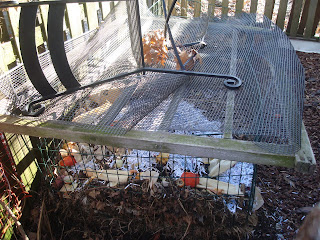The basics of making compost are simple. You need green (nitrogen rich) and brown (carbon rich) stuff to add to your pile. Piles also need air and moisture, but not too much moisture. Picky compost people try to balance browns and greens with a 3 to 1 ratio. I'm not that picky. However, if my compost starts to stink, I add some more browns (like leaves and/or shredded paper) so that it won't stink. Stinky compost means that you have too many greens and not enough browns.
[Today's kitchen scraps]
[Since it is March, perhaps I should toss my Charlie Brown poinsettia into the pile.]
For green stuff, I add fresh plant-based materials from my kitchen and yard to my pile. Green stuff generates heat for the pile. These materials include vegetable and fruit scraps, old baked goods, coffee grounds, tea leaves, manures from plant eating animals like horses, weeds (no seed heads or roots from invasive plants), grass clippings, green leaves, and in my case, neglected and otherwise past their prime plants.
For brown stuff, I add shredded junk mail and paper, leaves, cornstalks, hay, and sawdust. Be careful with paper. Anything cheap is usually fine to use because it's either made with soy or clay based inks. I don't add fancy, glossy printed paper to my compost because there's a strong possibility that the inks contain heavy metals or petroleum derivatives. I also shred paper because when I haven't, I've gotten clumps of unfinished paper in my compost. The shredding also makes the compost lighter so that more air can penetrate the pile. Since I tend to have a lot of greens in the summer because of yard waste, I typically keep a couple of bags of leaves from the fall to add to my pile if it starts to smell bad.
I would avoid composting animal products, sticks and branches, fats/oils, diseased plants, invasive plants/roots, seedy weeds, and/or manure from animals that consume meat.
Some people use compost starters, but this really isn't necessary. Organic materials will decompose well with or without the starter.
I compost using a three bin system: one bin for adding materials, one for decomposing, and a finished bin for using. My first bin was made from chicken wire, but I didn't like it. The compost was difficult to get out of the chicken wire because the finished compost would spill a little through the sides at the bottom and get roots tangles through the wire, making the bin difficult to remove from around the compost. I bought some plastic-coated wire bins that I like. I hold the sides together with plastic-coated garden wire that is easy to remove, thereby making the bins easy to disassemble when I need to empty the bin.
I have an old coldframe top with deer fencing stapled to it on top of the compost bin because of my dogs. They view the compost bins as a personal snack bar. Once they eat their half-rotten 'snacks', they come in the house and throw up. The stapled fencing and coldframe worked for a while, until one of them figured out that he could stand on the fencing and use his weight to break through the fencing to get to the 'goodies.' That's why there's a chair on top of the bin. One of my projects this summer is to create a better lid for my compost pile.

After a half year or so, all of this garbage becomes

half finished compost that I may or may not turn. Some people actively manage their piles, turning the piles every couple of weeks. Turning the pile provides the piles with more oxygen and redistributes the greens which in turn causes the piles to decompose faster. The beauty of compost is that it will still decompose if you do nothing. It will just take longer without the turning. I'm in no hurry, and I'm not a picky composter, so I usually just throw my stuff into the pile and ignore it until

it looks like this photo. This compost is finished and ready to use in my garden. In fact, today, I moved a large portion of it to the lot at the end of my alley so that I can use it in the raised beds that I'm going to build this spring. The miracle is that this pile was a bunch of junk mail, newspapers, phone book pages, yard waste, and kitchen scraps a year ago. Now it's this beautiful, nutrient-rich compost full of worms.
Between composting and recycling, I typically only throw one kitchen-sized bag of garbage away a week.







No comments:
Post a Comment